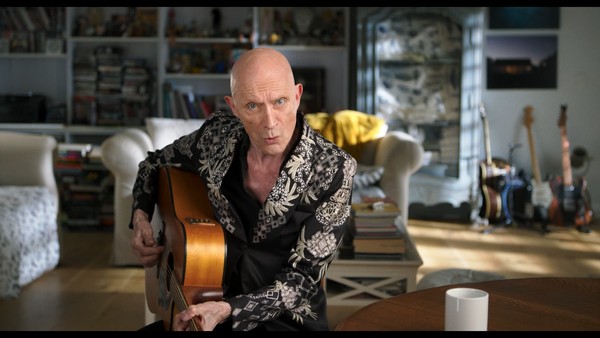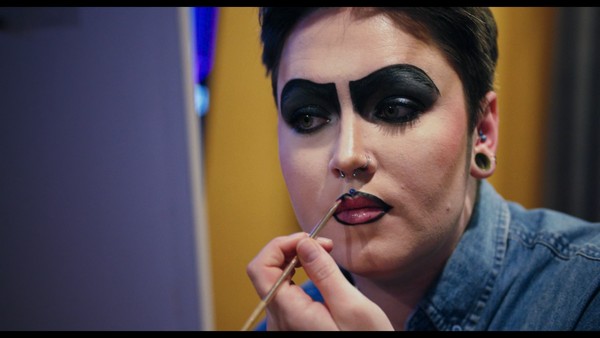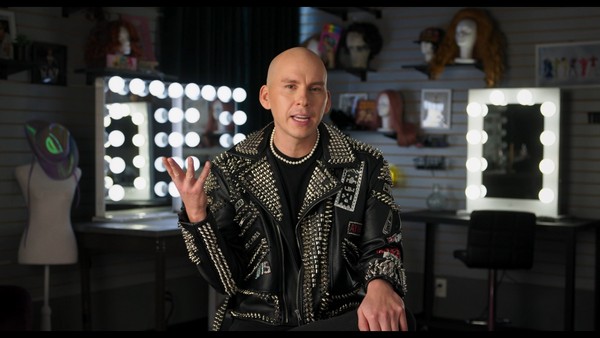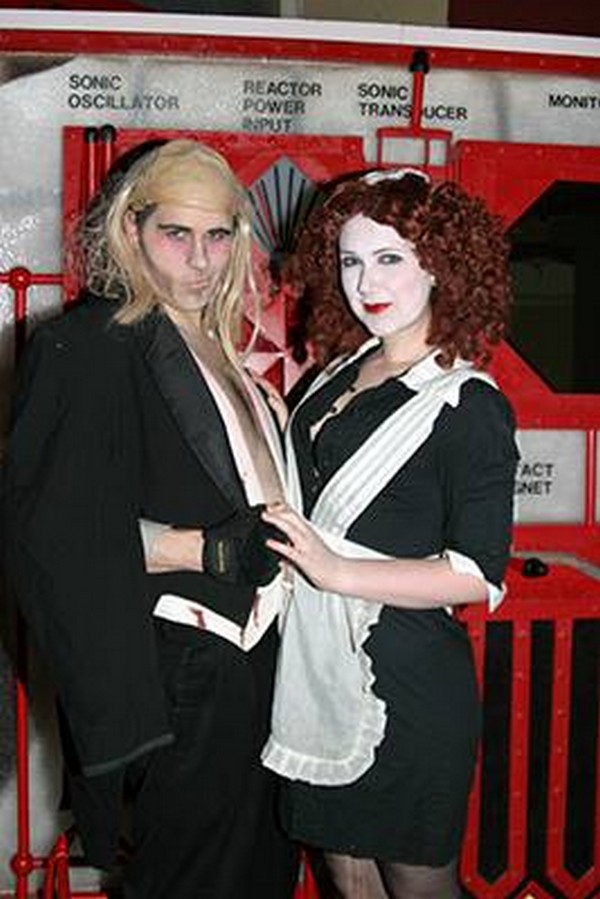 The hows, whys, history, and importance of the cult classic The Rocky Horror Picture Show are explored in Linus O’Brien’s heartfelt documentary Strange Journey: The Story of Rocky Horror.
The hows, whys, history, and importance of the cult classic The Rocky Horror Picture Show are explored in Linus O’Brien’s heartfelt documentary Strange Journey: The Story of Rocky Horror.
I would like… if I may… to take you on a strange journey about my connection to Strange Journey. So it’s clear, I’m very close to the subject of Linus O’Brien’s documentary. I was heavily involved in the worldwide community around The Rocky Horror Picture Show for nearly twenty years as a shadowcaster. I was one of those weirdos who would re-enact the film in front of the screen, with costumes, props, thrown items, and lines yelled. I met my wife at Rocky Horror! We were on several casts together, locally in Seattle/Tacoma and at conventions around the country, playing Riff Raff and Magenta (and everyone else). I lived, slept, and breathed Rocky Horror. But even being so close, I did my best to take it honestly as a neutral reviewer.
With that all said, director Linus O’Brien, son of Rocky Horror creator Richard, crafts a fantastic and fascinating documentary detailing the creation, explosion, and continuing legacy of the stage show, film, and the shadowcast phenomenon. He’s gathered a great collection of personalities involved on all levels and eras to talk frankly about it, but also to celebrate the past fifty years. Strange Journey is a documentary that will chill, thrill, and fulfill regular Frankie fans, but is enlightening and welcoming to Rocky Horror virgins (just as your weekly show should be).
Over the past five decades, Rocky Horror has been a rite of passage. While a stage hit in London from day one in 1973, and an initial movie flop in September of 1975, it returned to life in the form of shadowcasting: a version of raucous rock-n-roll audience participation. It’s a whole thing, and it happened organically (as the documentary will tell you). It’s part play, part movie, all awesome. Everyone needs to do it at least once. For many, they get dragged to the show, and it opens their eyes to a brave new world. They never leave. But many attendees, virgin and veteran, may not know the full story of how it got there; that’s what O’Brien aims for: a comfortable, fun, and friendly look at the history of the show, movie, and phenomenon.
 It’s fascinating to listen to Richard O’Brien, Tim Curry, Richard Hartley, Jim Sharman, Susan Surrandon, Pat Quinn, etc., tell their slice of Rocky Horror. They’ve been telling these stories and singing these songs (Richard sings them again with a longing sweetness) for fifty years in interviews, at conventions, in other documentaries, on various physical media releases, but they remain as fresh as the first time. The gusto is infectious, giving life to the documentary. I was fully engaged despite knowing much of the story. But not all of it, even for Rocky lifers, there are new tales, photos, and behind-the-scenes. There is a wonderful casual feeling to the storytelling. It helps that the creator of the documentary is the son of the creator of the show. He’s known and been around it his whole life, a toddler at Rocky Horror’s birth. His interviews and the way people talk to him are like catching up with an old friend.
It’s fascinating to listen to Richard O’Brien, Tim Curry, Richard Hartley, Jim Sharman, Susan Surrandon, Pat Quinn, etc., tell their slice of Rocky Horror. They’ve been telling these stories and singing these songs (Richard sings them again with a longing sweetness) for fifty years in interviews, at conventions, in other documentaries, on various physical media releases, but they remain as fresh as the first time. The gusto is infectious, giving life to the documentary. I was fully engaged despite knowing much of the story. But not all of it, even for Rocky lifers, there are new tales, photos, and behind-the-scenes. There is a wonderful casual feeling to the storytelling. It helps that the creator of the documentary is the son of the creator of the show. He’s known and been around it his whole life, a toddler at Rocky Horror’s birth. His interviews and the way people talk to him are like catching up with an old friend.
Strange Journey felt the same to me: (I’m) Going Home to a place where I’ve spent so much of my life, a Time Warp if I may. I miss shadowcasting. I miss the feel, the people, the rush of the show. The lingering odor of sweat, sex, and desperation. It’s more than just liking a movie. O’Brien knows this, as he and his subjects don’t just look at the HOWS of Rocky, but the WHYs. Why does it persist? What is so special about it to play at hundreds of theatres every weekend? Mixed into the creation stories, and most important for Rocky Horror in my eyes, is the personal nature of it all. Whether new or archival clips, it’s a joy to hear personal stories of the importance of Rocky Horror to people’s lives. One hears it, sees it, experiences it for the first time, and it connects to a wavelength you didn’t know existed. It connects and says, ” This is mine. These are my people.” It’s a place to open up, be someone else, or be the true self. It breaks the shell. For many, it fundamentally changes everything.
Rocky Horror is a Safe Space. Before the relative safety of modern society (the US government and others be damned), to be one’s authentic self. Niches and connections can be found online. But before, Rocky Horror was the place for the freaks, geeks, and assorted weirdos. One archival clip has a woman: “five days a week, I’m a nurse. But every weekend, I’m a star!” That’s the power of Rocky Horror and the power of Strange Journey.
 As a documentary, moving away from the ins and outs of the subject matter, it’s solidly built. Too often, documentaries as wide-ranging as this skimp out, sliding across ideas and moments, with the audience begging to explore some nugget dropped. Or delves too deep, and the viewer who isn’t versed in the topic becomes lost or waits to move on. Strange Journey, even to an outsider, is easy to engage with the audience, not getting lost in the who’s this and what happened? O’brein parses out the information, stories, talking heads, clips, and overall rise, fall, and resurgence of Rocky with great pacing. The mixed media method, cutting from the current interviews to film clips, live shows, pop culture references, and more, keeps a spark and interest. It has a beat. It’s a ninety-minute documentary with three clear acts.
As a documentary, moving away from the ins and outs of the subject matter, it’s solidly built. Too often, documentaries as wide-ranging as this skimp out, sliding across ideas and moments, with the audience begging to explore some nugget dropped. Or delves too deep, and the viewer who isn’t versed in the topic becomes lost or waits to move on. Strange Journey, even to an outsider, is easy to engage with the audience, not getting lost in the who’s this and what happened? O’brein parses out the information, stories, talking heads, clips, and overall rise, fall, and resurgence of Rocky with great pacing. The mixed media method, cutting from the current interviews to film clips, live shows, pop culture references, and more, keeps a spark and interest. It has a beat. It’s a ninety-minute documentary with three clear acts.
I appreciate the tightness in working for just ninety minutes. O’Brien keeps a laser (capable of emitting a beam of pure antimatter?) focus on Rocky Horror. It would be easy to expand into tangents: the wider view of the the various times, the continuing run of the stage show (the documentary leaves it after a bBroadway fizzle in 1975) similar cult followings that sprung up around other films (attempting to replicate Rocky or not… ahem repo), the remake, or the debacle around the sequel Shock Treatmenet. Yes, Rocky Horror has a sequel. It’s a mess due to a writer’s strike, but it has amazing music and a feeling of its own. I love it, and yes, have shadowcasted it. It’s the flow of the phenomenon over a flood of information. Kudos for not overloading the guests, Trixie Matell opens the film with his story, earning an empathetic connection; telling the audience this isn’t a straightforward “how we did it”. Jack Black brings his impish delight to his tale of eye-opening experience. Rocky Horror awoke the Jack Black we know.
For someone like me, Strange Journey brings back the warm and fuzzies. It’s a strut down memory lane. I was on that lane for two decades, while others stepped on it for a few hours one Saturday in their youth. No matter how long, it’s clear how important Rocky Horror is as the crossdressing granddaddy of cult films. There is nothing like it. Linus O’Brien’s Strange Journey is a beautiful tribute to fifty years of sweet tranvestites and late-night double-feature picture shows.
Don’t Dream It Be It.

